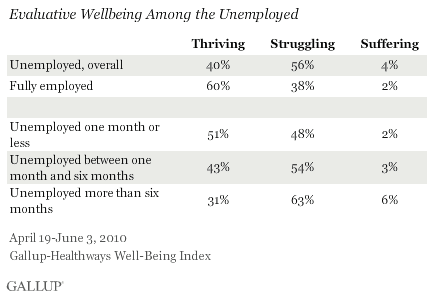WASHINGTON, D.C. -- Americans who are unemployed for more than six months are much more likely to experience daily negative emotions, including worry, sadness, and stress and somewhat less likely to report positive emotions, such as happiness, than are those who are unemployed for a shorter time.

As an example of the emotional toll of longer term unemployment, of those out of work for more than six months, 55% say they experienced worry during the previous day. This compares with 46% among those unemployed for a month to six months and the 40% for those without a job for less than a month who said the same.
The longer term unemployed are also more likely than those unemployed less than six months to report having at some point been told by a doctor or nurse that they suffer from depression, and they are more than twice as likely as the employed to have a depression diagnosis. While it is reasonable to assume that unemployment contributes to depression, it is also possible that individuals suffering from depression may be more likely to lose their job and to struggle to find new employment.

These results are based on April 19-June 3 interviews with 2,843 unemployed adults, aged 18 and older, conducted as part of Gallup Daily tracking and the Gallup-Healthways Well-Being Index. Gallup classifies respondents as unemployed if they are not working, are actively looking for work, and are available for work. Gallup classifies respondents as employed if they are working full time or are working part time but do not want to work full time. Gallup previously reported findings regarding the length of unemployment and revealed that 35% of unemployed Americans have been actively looking for work six months or more, while approximately 25% have been looking one month or less.
The majority of the unemployed are "struggling" (56%), which stands in contrast to the less than half of the employed who are struggling (38%). The Gallup-Healthways Well-Being Index classifies Americans as either "thriving," "struggling," or "suffering," according to how they rate their current and future lives on a ladder scale based on the Cantril Self-Anchoring Striving Scale. As length of unemployment increases for those who are unemployed, the percentage of those struggling also increases. Relatively few of the unemployed are classified as suffering, regardless of length of unemployment.

Bottom Line
These findings suggest that emotional well-being deteriorates with length of unemployment, and even those unemployed for less than a month are not immune from the stressors of joblessness. However, it is important to note that the data do not prove causality and that other explanations could exist. For example, individuals who experience lower emotional well-being may be more likely to become unemployed or to have difficulty finding new employment. Still, as unemployment drags on and optimism for finding a job in the near future declines, being without a job appears to be taking an emotional toll on unemployed individuals.
Survey Methods
Results are based on telephone interviews with a random sample of 2,843 national adults, aged 18 and older, who are not working, who are actively looking for work, and who available for work, as conducted as part of Gallup Daily tracking April 19-June 3, 2010. For results based on the total sample of national adults, one can say with 95% confidence that the maximum margin of sampling error is ±2.3 percentage points. All reported margins of sampling error include the computed design effects for weighting and sample design.
Interviews are conducted with respondents on landline telephones and cellular phones, with interviews conducted in Spanish for respondents who are primarily Spanish speaking. Each sample includes a minimum quota of 150 cell phone respondents and 850 landline respondents, with additional minimum quotas among landline respondents for gender within region. Landline respondents are chosen at random within each household on the basis of which member had the most recent birthday.
Samples are weighted on the basis of gender, age, race, Hispanic ethnicity, education, region, adults in the household, cell phone-only status, cell phone-mostly status, and phone lines. Demographic weighting targets are based on the March 2009 Current Population Survey figures for the aged 18 and older non-institutionalized population living in U.S. telephone households.
The Gallup-Healthways Well-Being Index is based on the Cantril Self-Anchoring Striving Scale, which asks people to evaluate their present and future lives on a scale with steps numbered from 0 to 10, where "0" is the worst possible life and "10" is the best possible life. Those who rate today a "7" or higher and the future an "8" or higher are considered to be "thriving." Those who rate today and the future a "4" or lower on the scale are considered to be "suffering."
In addition to sampling error, question wording and practical difficulties in conducting surveys can introduce error or bias into the findings of public opinion polls.
